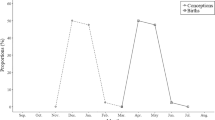Summary
The suckling behaviour of 130 freeranging elephant calves aged between birth and 4.5 years old was examined in Amboseli National Park, Kenya. Analyses of frequencies of suckling and durations of suckling bouts showed that males attempted to suckle more often, were more successful at their attempts, and as a result were estimated to have a higher milk intake than did female calves. Mothers were equally tolerant of their sons' and daughters' demands to suckle at young ages, but were less tolerant of their older sons' demands. The growth rates of males based on hind footprint length were faster than those of females from birth onwards. During drought years with low food availability, male calf survivorship in the first year was lower than that of female calves. During wet years, there was little difference between sexes in survivorship. It appeared that during dry years mothers were unable to sustain milk production at a level that met the metabolic requirements of their sons, and as result male calves were more likely to die. Females with a surviving son tended to have a longer interbirth interval than did females with a surviving daughter. We suggest that greater early maternal investment in male calves occurs because, in the highly-competitive polygynous mating system of elephants, size in adult male elephants is an important factor in mating success.
Similar content being viewed by others
References
Alexander RD, Hoogland JL, Howard RD, Noonan, M, Sherman PW (1979). Sexual dimorphism and breeding systems in pinnipeds, ungulates, primates and humans. In: Chagnon NA, Irons W (eds) Evolutionary biology and human social behaviour: an anthropological perspecitve. Duxbury Press, North Scituate, Massachusetts, pp 402–435
Altmann J (1974) Observational study of behavior: Sampling methods. Behaviour 49:227–267
Berger J (1979) Weaning conflict in desert and mountain bighorn sheep (Ovis canadensis): An ecological interpretation. Z Tierpsychol 50:188–200
Brody S (1945) Bioenergetics and growth. Rheinhold, New York
Carlisle TR (1982) Brood success in variable environments: implications for parental care allocation. Anim Behav 30:824–836
Clutton-Brock TH, Albon SD (1982) Parental investment in male and female offspring in mammals. In: King's College Sociobiology Group (eds) Current problems in sociobiology. Cambridge University Press, Cambridge, pp 223–247
Clutton-Brock TH, Albon SD, Guinness FE (1981) Parental investment in male and female offspring in polygynous mammals. Nature 289:487–489
Clutton-Brock TH, Albon SD, Guinness FE (1985) Parental investment and sex differences in juvenile mortality in birds and mammals. Nature 313:131–133
Clutton-Brock TH, Guinness FE, Albon SD (1982) Red deer: behavior and ecology of two sexes. The University of Chicago Press, Chicago
Duncan P, Harvey PH, Wells SM (1984) On lactation and associated behaviour in a natural herd of horses. Anim Behav 32:244–263
Fletcher IC (1971) Relationships between frequency of suckling, lamb growth and post-partum oestrous behaviour in ewes. Anim Behav 19:108–111
Guinness FE, Hall MJ, Cockerill RA (1979) Mother-offspring association in red deer. Anim Behav 27:536–544
Hanks J (1972) Growth of the African elephant (Loxodonta africana). East Afr Wildl J 10:251–272
Laws RM (1966) Age criteria for the African elephant, Loxodonta a. africana. East Afr Wildl J 4:1–37
Laws RM, Parker ISC, Johnstone RCB (1975) Elephants and their habitats: the ecology of elephants in North Bunyoro, Uganda. Clarendon Press, Oxford
MacNair MR, Parker GA (1978) Models of parent-offspring conflict: II polygyny. Anim Behav 26:111–222
McEwan EH, Whitehead PE (1971) Measurement of the milk intake of reindeer and caribou calves using tritiated water. Can J Zool 49:443–447
Maynard Smith J (1980) A new theory of sexual investment. Behav Ecol Sociobiol 7:247–251
Millar JS (1977) Adaptive features of mammalian reproduction. Evolution 31:370–386
Moss CJ (1983) Oestrous behaviour and female choice in the African elephant. Behaviour 86:167–196
Moss CJ, Poole JH (1983) Relationships and social structure of African elephants. In: Hinde RA (ed) Primate social relationships: an integrated approach. Blackwell Scientific Publications, Oxford, pp 315–325
Parket GA, MacNair MR (1978) Models of parent-offspring conflict: I monogamy. Anim Behav 26:97–110
Pollard JH (1977) A handbook of numerical and statistical techniques. Cambridge University Press, Cambridge
Poole JH (1982) Musth and male-male competition in the African elephant. PhD thesis, University of Cambridge
Poole JH, Moss CJ (1981) Musth in the African elephant, Loxodonta africana. Nature 292:830–831
Reinhardt V, Reinhardt A (1981) Natural suckling performance and age of weaning in Zebu cattle (Bos indicus). J Agric Sci 96:309–312
Reiter J, Stinson NL, LeBoeuf BJ (1978) Northern elephant seal development: the transition from weaning to nutritional independence. Behav Ecol Sociobiol 3:337–367
Robbins CT and Moen ANM (1975) Milk consumption and weight gain of white-tailed deer. J Wildl Manag 39:355–360
Sadlier RMFS (1980) Energy and protein intake in relation to growth of suckling black-tailed deer fawns. Can J Zool 58:1347–1354
Trivers RL (1972) Parental investment and sexual selection. In: Cambell B (ed) Sexual selection and the descent of man. Aldine, Chicago, pp 136–179
Trivers RL (1974) Parent-offspring conflict. Am Zool 14:249–264
Verme LJ (1963) Effect of nutrition on growth of white-tailed deer fawns. Trans North Am Wildl Conf 20:431–443
Western D, Moss CJ, Georgiadis N (1983) Age estimation and population age structure of elephants from footprint dimensions. J Wildl Manag 47:1192–1197
Western D, Lindsay WK (1984) Seasonal herd dynamics in a savannah elephant population. Afr J Ecol 22:229–244
Author information
Authors and Affiliations
Rights and permissions
About this article
Cite this article
Lee, P.C., Moss, C.J. Early maternal investment in male and female African elephant calves. Behav Ecol Sociobiol 18, 353–361 (1986). https://doi.org/10.1007/BF00299666
Received:
Accepted:
Published:
Issue Date:
DOI: https://doi.org/10.1007/BF00299666




